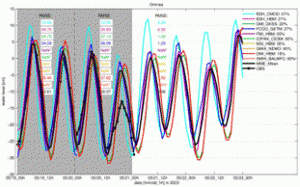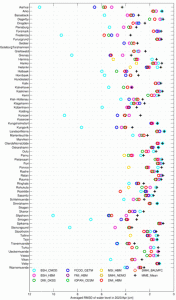In the Baltic Sea, BOOS members exchange national forecasts and observations in near real time. This made it possible for conducting MME forecast, in which observations are used to estimate weights of different forecasts, then an “optimal forecast” is made based on a linear aggregation of the weighted forecasts. Currently there are two operational practices using MME: one is developed by BSH by integrating multi-model forecast with in-situ sea level observations, as an effort of CMEMS (Golbeck et al., 2015, http://www.boos.org/multi-model-ensemble-of-forecast-products/), and the other by DMI with aggregating multi-model forecasts with satellite observations for FRONTEX pan-European Sea met-ocean condition forecast. The BSH effort also provides multi-model ensemble for other ocean state variables without using observations.


Figure 1. Left: MME forecast at Grenaa station; Right: Validation of MME forecast in April 2023. The MME forecast are superior than any of the individual forecasts.
For more details:
- 2020/21 MME WG Annual report
- 2021/22 MME WG activity summary
- Member presentations & publications











